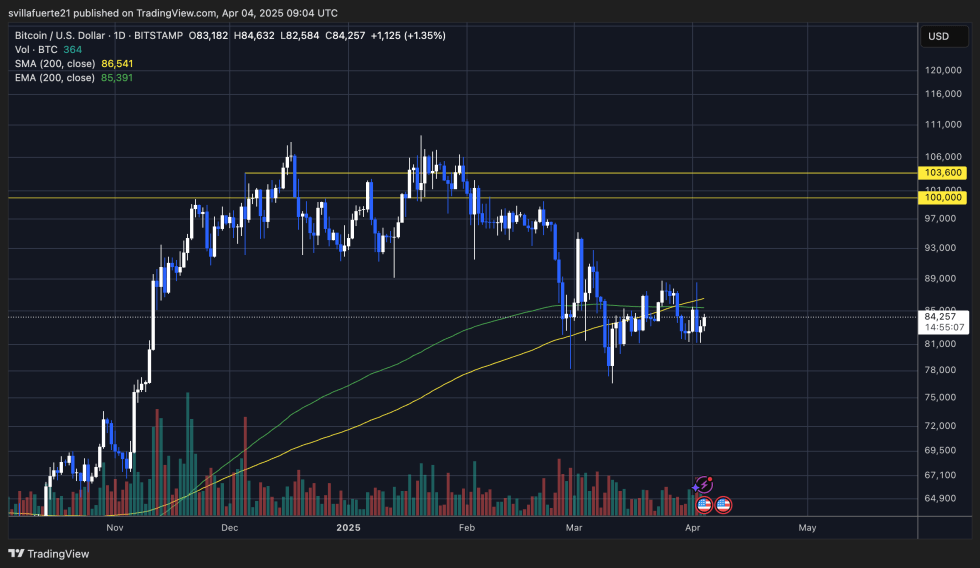Shifts in trader behavior, technical correction signals, and broader macroeconomic ripples are defining the latest moves in the crypto landscape. From Dogecoin’s massive open interest drop to cautious moves by Bitcoin short-term holders, the signs point to a more conservative market sentiment in the short term. Meanwhile, even gold-backed cryptocurrencies—typically viewed as safe havens—are experiencing declines amid global market turbulence, reflecting the far-reaching impact of current financial conditions.
Dogecoin Faces Sharp Decline in Open Interest, Signaling Waning Speculator Enthusiasm
Dogecoin’s open interest has experienced a staggering 70.5% drop since mid-January, marking a significant shift in trader behavior. Open interest reflects the total number of outstanding derivative contracts—futures and options—that haven’t been settled. A sharp decline in this metric often points to a retreat of speculative capital. For Dogecoin, a meme coin heavily reliant on community buzz and retail speculation, this decline could be a harbinger of reduced liquidity and slower price movement in the near term.
This drop aligns with a broader cooling-off period for altcoins, as capital rotates toward safer or more fundamentally supported assets. Dogecoin, with its meme-driven momentum and limited fundamental utility, has always been more vulnerable to sudden shifts in trader sentiment. Leveraged traders may be exiting due to increased volatility or lower expected returns, further weakening DOGE’s price stability. Notably, social media activity and meme coin hype have also seen a downtick, removing a key driver of demand.
The technical indicators for DOGE suggest a lack of immediate recovery signals. Without new speculative inflows or a fresh wave of hype, Dogecoin may continue trading sideways or trend lower. Long-term holders may not be swayed by these short-term changes, but the absence of new capital and trader activity is a red flag for short- to mid-term price action.
Market Impact: The decline in open interest for Dogecoin could reduce its short-term volatility but also limits upside momentum. For traders, it signifies reduced speculative opportunities, while for investors, it signals a period of consolidation or potential weakness in meme coin narratives.
Short-Term Bitcoin Holders Pause Accumulation, Hinting at Sentiment Weakness
Recent data shows that short-term Bitcoin holders (STHs) have stopped increasing their BTC exposure, a move interpreted as a growing lack of confidence in the asset’s near-term prospects. These investors, who typically hold BTC for less than 155 days, often act as sentiment bellwethers. When STHs start accumulating, it usually signals optimism. Conversely, when they stall or sell, it hints at market uncertainty or expectations of lower prices.
This behavioral shift comes as Bitcoin faces macroeconomic headwinds and uncertainty around upcoming monetary policies. STHs may be positioning themselves conservatively due to the potential for short-term corrections or lack of bullish catalysts. Historically, such pauses in accumulation have preceded consolidation phases or mild corrections. While this does not necessarily predict a market crash, it emphasizes a cautious sentiment prevailing in the market.
Moreover, this stagnation could also reduce buying pressure, making Bitcoin more vulnerable to downward moves triggered by broader market sentiment or external shocks. If long-term holders (LTHs) also begin reducing their positions, the bearish narrative could gain traction. On the other hand, if institutional inflows or bullish news emerge, sidelined STHs could re-enter, potentially reigniting momentum.
Market Impact: The stalling of STH accumulation introduces short-term bearish pressure on BTC. While not catastrophic, it may delay bullish momentum and encourage a period of sideways or downward movement, especially if not counterbalanced by institutional or long-term holder activity.
Bitcoin Realized Price Model Warns of Extended Correction Period
The Realized Price model—especially the Inter-Cycle Cohort Age (ICCA) version—has signaled a “Dead Cross,” which historically indicates the onset of a correction phase within Bitcoin bull cycles. This technical signal emerges when short-term investor cost basis moves above the long-term cohort’s, implying short-term traders are underwater, often leading to selling pressure and reduced confidence. Based on past cycles, such correction phases average about 85 days.
This model’s current prediction places the correction at roughly 28 days in, suggesting nearly two months more of potential consolidation or downward movement. Though this doesn’t negate the larger bull market narrative, it does call for caution. The Dead Cross represents a cooling-off period as speculative froth is reduced, and market fundamentals regain focus. It also suggests that the cycle’s emotional highs may have peaked temporarily, and market maturity is taking precedence.
Investors and traders are advised to brace for lower volatility and potentially stagnant prices. This phase can also act as a healthy reset, allowing stronger hands to accumulate while weaker hands exit. Monitoring this model helps in adjusting strategy—whether to stay sidelined, accumulate on dips, or hedge existing positions. If external factors like macroeconomic easing or ETF inflows arise, they could shorten the predicted correction duration.
Market Impact: While not immediately alarming, the Dead Cross and predicted correction period imply continued choppiness in BTC markets. Long-term investors may view it as a buying opportunity, but traders should remain cautious and manage risk tightly.
Gold-Backed Cryptocurrencies Retreat Amid Broader Market Chaos
Gold-backed cryptocurrencies like Paxos Gold (PAXG) and Tether Gold (XAUT) have seen sharp pullbacks from recent highs, correlating with global stock market turbulence. These digital assets, typically seen as hedges against fiat instability and equity volatility, initially rallied following political developments like tariff announcements. However, their recent retreat underscores that even “safe-haven” cryptos are not entirely immune to macroeconomic shocks.
The initial surge was driven by fear-based demand—investors looking for alternatives to traditional assets amid rising inflation and geopolitical risks. However, the pullback reflects either profit-taking or a shift in broader risk-off sentiment, where investors liquidate across the board to raise cash. It also indicates that while gold-backed cryptos mimic the price of physical gold, they still operate within the broader, more volatile crypto ecosystem.
This correction does not necessarily undermine their long-term utility but calls for better education around their behavior during market stress. Institutional interest in tokenized commodities remains high, and such retracements could offer entry points for those with a long-term thesis. That said, the interconnectedness of all asset classes during crisis periods is now more visible than ever—even for digitized gold.
Market Impact: The decline in gold-backed cryptos during a market rout reflects rising cash demand and de-risking. While it may be short-lived, it exposes vulnerabilities in their “safe-haven” narrative during systemic sell-offs. Watch for rebound potential if market fear subsides.
Key Takeaways
-
Dogecoin Open Interest Drop: A 70.5% decline in Dogecoin’s open interest highlights reduced speculative activity and trader enthusiasm, suggesting limited short-term upside.
-
Bitcoin STH Behavior: Short-term Bitcoin holders have halted accumulation, signaling cautious sentiment and potential for extended consolidation or sell pressure.
-
Realized Price Model Correction Warning: Technical signals like the “Dead Cross” suggest Bitcoin may be in a prolonged correction phase, possibly lasting several more weeks.
-
Gold-Backed Crypto Pullback: PAXG and XAUT retreated from all-time highs, reflecting broader market panic and profit-taking even among perceived safe-haven assets.
-
Retail & Institutional Caution: Both retail traders (DOGE, BTC) and institutional investors (gold-backed cryptos) are reacting defensively to macroeconomic instability.
-
Volatility Across Safe-Haven Assets: The dip in tokenized gold shows that even stable assets can lose ground in widespread financial sell-offs.
-
Market Sentiment Shift: Overall, the mood is risk-averse, with investors pulling back from both speculative and defensive positions as uncertainty looms.






